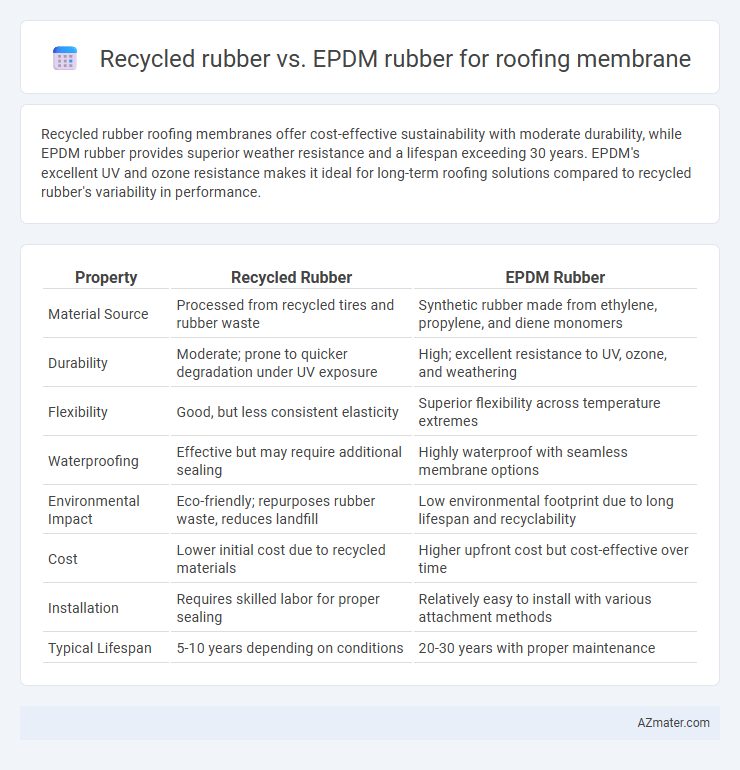Recycled rubber roofing membranes offer cost-effective sustainability with moderate durability, while EPDM rubber provides superior weather resistance and a lifespan exceeding 30 years. EPDM's excellent UV and ozone resistance makes it ideal for long-term roofing solutions compared to recycled rubber's variability in performance.
Table of Comparison
| Property | Recycled Rubber | EPDM Rubber |
|---|---|---|
| Material Source | Processed from recycled tires and rubber waste | Synthetic rubber made from ethylene, propylene, and diene monomers |
| Durability | Moderate; prone to quicker degradation under UV exposure | High; excellent resistance to UV, ozone, and weathering |
| Flexibility | Good, but less consistent elasticity | Superior flexibility across temperature extremes |
| Waterproofing | Effective but may require additional sealing | Highly waterproof with seamless membrane options |
| Environmental Impact | Eco-friendly; repurposes rubber waste, reduces landfill | Low environmental footprint due to long lifespan and recyclability |
| Cost | Lower initial cost due to recycled materials | Higher upfront cost but cost-effective over time |
| Installation | Requires skilled labor for proper sealing | Relatively easy to install with various attachment methods |
| Typical Lifespan | 5-10 years depending on conditions | 20-30 years with proper maintenance |
Introduction to Roofing Membranes
Recycled rubber and EPDM rubber are prominent materials used in roofing membranes, each offering distinct environmental and performance benefits. EPDM (ethylene propylene diene monomer) rubber is known for its excellent weather resistance, UV stability, and longevity, making it a preferred choice in commercial roofing applications. Recycled rubber membranes provide a sustainable alternative by repurposing waste materials, enhancing environmental impact while maintaining flexibility and durability comparable to virgin EPDM membranes.
Overview of Recycled Rubber Roofing
Recycled rubber roofing membranes are made primarily from reclaimed tires and industrial rubber waste, offering an eco-friendly alternative to traditional EPDM roofing. These membranes provide excellent durability, flexibility, and resistance to weathering, UV radiation, and ozone, while significantly reducing landfill waste. Cost-effective and sustainable, recycled rubber membranes often feature similar performance characteristics to EPDM but with a lower environmental impact due to their recycled content.
What is EPDM Rubber Membrane?
EPDM rubber membrane is a highly durable synthetic elastomer widely used for roofing due to its excellent resistance to UV rays, ozone, and extreme weather conditions. Unlike recycled rubber, EPDM offers superior elasticity and a longer lifespan, making it an ideal choice for commercial and residential roofing applications. Its seamless installation and low maintenance requirements contribute to energy efficiency and reduced life cycle costs.
Sustainability and Environmental Impact Comparison
Recycled rubber roofing membranes reduce landfill waste and lower carbon footprints by repurposing materials, offering a sustainable alternative to virgin products. EPDM rubber, while durable and energy-efficient due to its heat-reflective properties, requires energy-intensive manufacturing and is less biodegradable. Choosing recycled rubber supports circular economy principles by minimizing resource extraction and promoting waste diversion in roofing applications.
Durability and Weather Resistance
Recycled rubber roofing membranes offer strong durability and resistance to UV rays, making them suitable for eco-friendly roofing solutions. EPDM rubber roofs are highly praised for exceptional weather resistance, maintaining flexibility and integrity under extreme temperatures, hail, and ozone exposure. EPDM generally outperforms recycled rubber in long-term weather durability, often lasting 30 years or more with minimal degradation.
Installation Process and Ease
Recycled rubber roofing membranes often require specialized adhesives and precise surface preparation to ensure proper bonding, making installation moderately complex compared to EPDM rubber. EPDM rubber membranes are known for their lightweight, flexible nature, and ability to be installed with simple peel-and-stick or mechanically fastened methods, resulting in a quicker and more straightforward installation process. The seamless characteristics of EPDM reduce potential leak points, enhancing installation efficiency and long-term durability.
Cost Analysis: Recycled Rubber vs EPDM
Recycled rubber roofing membranes typically cost 30-50% less than EPDM rubber, making them a budget-friendly option for large-scale projects. EPDM rubber offers higher durability and longer lifespan, potentially reducing long-term maintenance and replacement expenses despite its higher initial investment. The cost-effectiveness of recycled rubber is advantageous for short-term projects, while EPDM provides better value over time due to superior weather resistance and warranty coverage.
Performance in Different Climates
Recycled rubber roofing membranes offer excellent durability and UV resistance, making them suitable for moderate climates with fluctuating temperatures. EPDM rubber is highly versatile, providing superior weather resistance, flexibility in extreme cold, and strong protection against heat and UV exposure, ideal for both hot and cold regions. Performance in diverse climates favors EPDM due to its ability to withstand severe temperature swings and resist cracking or degradation over time.
Maintenance Requirements and Longevity
Recycled rubber roofing membranes typically require more frequent inspections and maintenance due to potential inconsistencies in material quality, which can lead to earlier signs of wear or cracking compared to EPDM rubber. EPDM rubber roofing membranes offer superior durability with an average lifespan of 25 to 30 years and low maintenance needs, thanks to their resistance to UV radiation, ozone, and extreme weather conditions. Choosing EPDM ensures reduced maintenance costs and longer service intervals, making it a preferable option for long-term roofing solutions.
Which Roofing Membrane is Right for You?
Recycled rubber roofing membranes offer eco-friendly benefits with durability and cost-effectiveness, making them suitable for budget-conscious, sustainable projects. EPDM rubber membranes provide superior weather resistance and longevity, excelling in extreme temperature fluctuations and UV exposure. Choosing the right roofing membrane depends on project priorities like environmental impact, budget, and climate resilience.

Infographic: Recycled rubber vs EPDM rubber for Roofing membrane
 azmater.com
azmater.com